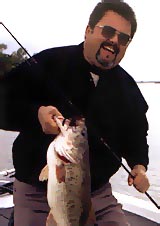 Many people outside the sport of fishing have no idea how big the sport is and even those involved in the sport may be surprised if they knew the economic impact the sport has on the economy.
Many people outside the sport of fishing have no idea how big the sport is and even those involved in the sport may be surprised if they knew the economic impact the sport has on the economy.
According to the National Sporting Goods Association in 2001, 44.4 million Americans, ages 7 and older, hit America’s waterways to go fishing. The U.S. Fish and Wildlife Service estimates that one out of every six Americans 16 and older enjoy going out for a day of fishing. Amazingly, they also average 16 days of fishing each year, adding up to an astounding 365 million freshwater fishing days each year, combined with saltwater trips, it jumps to 437 million days of fishing.
Fishing now ranks as the 4th most popular participation sport in the country, beating out bicycling, bowling, basketball, golf, jogging, baseball, softball, soccer, football and skiing. Only walking, swimming and camping are more popular – in fact, fishing is more popular than golf and tennis combined.
The number of young people taking up the sport has been increasing slowly, but there is still a lot of work to accomplish in this area. Only 17 percent of young people ranging from 16- to 17-years-old go fishing, comprising only 4 percent of all anglers.
Those of the male persuasion often think that fishing is a man’s sport – well, think again. More than 11 million women enjoy the sport, in fact, more women fish than play golf, tennis, or even jogging. Fishing is the 10th most popular sport among women. Female anglers make up 26.8 percent of all anglers, representing 8 percent of the population and they spend an average of $246 per year for trip-related fishing expenses of approximately $3 billion annually and their number of days fishing has been slowly increasing.
People with various disabilities are learning to enjoy the sport more these days; 1.9 million persons with disabilities took 33 million fishing trips.
Some may be surprised to find that 40 percent of all anglers live in urban areas with populations of more than 1 million people, 20 percent live in areas with populations of more than 250,000.
When we break the country up in regions we find that; 30 percent of all anglers live in the South, 27 percent in the Midwest, 20 percent in the West and 15 percent of all anglers live in the Northeast.
Many bass anglers might think that the reason to fish is for the competition, but according to the Future of Fishing project, 33 percent of all Americans fish to relax and 25 percent more consider it a way to spend time with family and friends.
If you want to increase the number of anglers, the answer is quite simple; get the children to ask their parents to go. Studies have shown that 65 percent of non-anglers and 88 percent of anglers would make time to go fishing, or at lease, would want to go more often if a child asks to go fishing.
None of us would be surprised to find that bass fishing is the most popular form of freshwater fishing; 38 percent of anglers fish for black bass; 28 percent5 fish for trout, 28 percent fish for panfish ad 27 percent fish for catfish.
Most anglers stick pretty close to home when they go fishing, 92 percent fish in their own state. It’s obvious that most anglers prefer fishing in ponds, lakes and reservoirs instead of rivers and streams. 85 percent of anglers fish flat water. Some will fish both, making 44 percent of anglers that will fish streams and rivers.
Now is where you can feel good about what you have chosen for a sport. The economic impact of fishing benefits everyone. In 2001 anglers spent $35.6 billion to pursue their sport. It breaks down like this; they spent $14 billion on fishing trips, $17 billion for equipment, $4 billion for licenses, stamps, land leasing and ownership, membership dues and contributions and magazine subscriptions. The total economic output generated by freshwater fishing in 2001 exceeded $74 billion, including the impact on retailers, suppliers of goods and services to retailers, wholesalers and manufacturers, plus the indirect and induced impacts resulting from these activities. Including saltwater fishing, economic output reached $116 billion.
The average angler spends $1,046 each year for fishing related expenses. Bass anglers expenditures are usually higher.
Freshwater fishing expenditures in 2001 generated more than $19.4 billion in wages. Including saltwater fishing, $30.1 billion in wages were generated (up 23 percent since 1991).
More than 683,892 full-time jobs exist due to freshwater fishing. Including saltwater fishing, the total exceeds 1 million (up 16 percent since 1991).
When it comes to taxes and revenues, anglers contribute a lot of money – fishing generated more than $1.9 million in state sales taxes in 2001 and generated more than $470 million in state income tax, and more than $4.8 million in federal income tax. In 1998, excise taxes applied to outdoors people provided more than $426 million to states for fish stocking, wildlife restoration and research, aquatic resource education, hunter education and other activities.
What these numbers show is the strength anglers have in our world. We talk about various environmental organizations and animal rights groups who always seem to have the ear of the government, but they are small in comparison to the number anglers and the economic power we possess. PETA, for instance, has a few hundred thousand members, far less than 44 million anglers nationwide and with numbers comes power. Not only numbers, but when we consider the revenue generated for state and federal governments, retailers and jobs created, anglers should have a strong voice and with those types of numbers, those in power, who have any brains, should listen.


 Advertising
Advertising